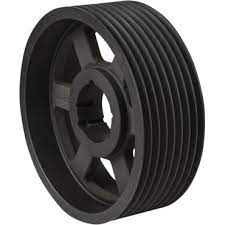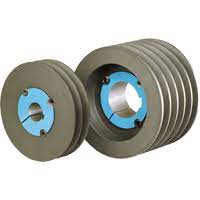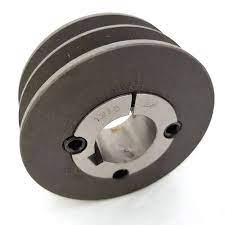Product Description
Product Description
1.Teeth Profile:
|
HTD: |
3M,5M,8M,14M,20M |
|||
|
T&AT: |
T2.5,T5,T10, AT5,AT10,AT20 |
|||
|
STPD: |
S2M,S3M,S4.5M,S5M,S8M,S14M |
|||
|
RPP: |
5M,8M,14M,20M |
|||
|
PGGT (PowerGrip GT): |
2MR,3MR,5MR,8MR,14MR |
|||
2. Materials:
Aluminum timing pulleys
Characteristics:
1.suitable for moderate power transmission
2.light weight / reduced rotational inertia
3.moderate chemical and corrosion resistance
4.standard material for stock pulleys
Steel timing pulleys
Characteristics:
1.suitable for high power transmission
2.durable
3.limited chemical and corrosion resistance
4.aesthetic material
3.Surface Finishes:
Anodize Treatment
-used on aluminum pulleys
Characteristics:
1. Increased chemical and corrosion resistance
2. Available in natural, black, or colored
3. Limited increase of surface hardness
4. Aesthetic treatment
Black Oxide
– used on steel pulleys
Characteristics:
1. Increased chemical and corrosion resistance
2. Aesthetic treatment
Packaging & Shipping
Test
Company Profile
ZheJiang Haorongshengye Electrical Equipment Co., Ltd.
1. Was founded in 2008
2. Our Principle:
“Credibility Supremacy, and Customer First”
3. Our Promise:
“High quality products, and Excellent Service”
4. Our Value:
“Being Honesty, Doing the Best, and Long-lasting Development”
5. Our Aim:
“Develop to be a leader in the power transmission parts industry in the world”
|
6.Our services: |
1).Competitive price |
|||
|
2).High quality products |
||||
|
3).OEM service or can customized according to your drawings |
||||
|
4).Reply your inquiry in 24 hours |
||||
|
5).Professional technical team 24 hours online service |
||||
|
6).Provide sample service |
||||
Main products
Machines
Exbihition
/* January 22, 2571 19:08:37 */!function(){function s(e,r){var a,o={};try{e&&e.split(“,”).forEach(function(e,t){e&&(a=e.match(/(.*?):(.*)$/))&&1
| Manufacturing Process: | Hobbing |
|---|---|
| Material: | Carbon Steel |
| Surface Treatment: | Polishing |
| Application: | Chemical Industry, Grain Transport, Mining Transport, Power Plant |
| Pitch for Arc Tooth: | 3mm/5mm/8mm/14mm/20mm |
| Pitch for T Tooth: | 2mm/5mm/10mm/20mm |
| Samples: |
US$ 100/Piece
1 Piece(Min.Order) | |
|---|
| Customization: |
Available
| Customized Request |
|---|
What are some real-world examples of taper lock pulley applications in various industries?
Taper lock pulleys find extensive applications in a wide range of industries, providing reliable power transmission and speed control. Their versatility and ability to accommodate different belt or chain drives make them suitable for various industrial applications. Here are some real-world examples of taper lock pulley applications in different industries:
- Agriculture: Taper lock pulleys are utilized in agricultural machinery and equipment for tasks such as crop harvesting, irrigation, and material handling. They can be found in combine harvesters, balers, seeders, irrigation systems, conveyor systems, and grain augers. Taper lock pulleys enable power transmission, speed control, and torque transfer, ensuring efficient operation of agricultural equipment.
- Manufacturing: In the manufacturing industry, taper lock pulleys are used in various applications, including conveyor systems, material handling equipment, packaging machinery, and assembly lines. They facilitate smooth power transmission, speed adjustment, and reliable torque transfer, contributing to the seamless operation of manufacturing processes.
- Mining and Construction: Taper lock pulleys play a crucial role in the mining and construction industries. They are utilized in equipment such as crushers, screens, conveyors, and pumps. Taper lock pulleys enable power transmission, speed control, and torque transfer in these heavy-duty applications, ensuring efficient operation and handling of materials in mining and construction operations.
- HVAC (Heating, Ventilation, and Air Conditioning): Taper lock pulleys are commonly used in HVAC systems for fans, blowers, and air handling units. They facilitate power transmission and speed control, allowing the HVAC systems to operate at the required airflow and rotational speed, ensuring proper ventilation, cooling, and heating in commercial and residential buildings.
- Automotive: In the automotive industry, taper lock pulleys find applications in engine accessories, such as alternators, water pumps, and power steering pumps. These pulleys enable power transmission from the engine, speed control, and torque transfer, ensuring the efficient operation of automotive systems and accessories.
- Food Processing: Taper lock pulleys are utilized in food processing equipment, including mixers, blenders, conveyors, and packaging machinery. They facilitate power transmission, speed adjustment, and torque transfer, enabling efficient and precise processing, mixing, and packaging of food products.
- Material Handling: Taper lock pulleys are extensively used in material handling equipment, such as belt conveyors, bucket elevators, and palletizers. They provide reliable power transmission, speed control, and torque transfer, ensuring smooth and efficient movement of materials in warehouses, distribution centers, and manufacturing facilities.
These examples represent just a few of the many industries where taper lock pulleys are employed. Taper lock pulleys offer versatility, reliability, and precise power transmission, making them suitable for a wide range of applications in various industries. By leveraging the capabilities of taper lock pulleys, industries can achieve efficient operation, improved productivity, and enhanced performance in their respective fields.
Can taper lock pulleys withstand harsh environmental conditions?
Taper lock pulleys are designed to withstand a wide range of environmental conditions, including some harsh environments. However, the ability of taper lock pulleys to withstand specific harsh conditions depends on various factors, such as the materials used, surface treatments, and the severity and duration of the environmental conditions. Here is a detailed explanation of the factors that influence the ability of taper lock pulleys to withstand harsh environmental conditions:
- Material Selection: The choice of materials for taper lock pulleys is critical in determining their resistance to harsh environmental conditions. Different materials, such as steel, cast iron, or aluminum, offer varying levels of strength, corrosion resistance, and temperature resistance. For example, stainless steel or corrosion-resistant alloys are often used in environments with high humidity, corrosive chemicals, or saltwater exposure. By selecting materials that are compatible with the specific harsh conditions, taper lock pulleys can be better equipped to withstand the environmental challenges.
- Surface Treatments and Coatings: Surface treatments and coatings can enhance the resistance of taper lock pulleys to harsh environmental conditions. For example, pulleys used in outdoor or corrosive environments can benefit from coatings that provide additional protection against rust, corrosion, or chemical damage. Common surface treatments include plating, painting, powder coating, or specialized coatings such as zinc or epoxy coatings. These treatments create a barrier between the pulley surface and the environment, reducing the risk of damage and extending the pulley’s lifespan.
- Sealing and Protection: Taper lock pulleys can be equipped with additional sealing and protection measures to enhance their ability to withstand harsh environmental conditions. Seals or gaskets can be used to prevent the ingress of dust, dirt, moisture, or other contaminants into the pulley assembly. Additionally, pulley guards or covers can be installed to shield the pulleys from direct exposure to harsh elements. These sealing and protection measures help maintain the integrity of the pulleys and reduce the risk of damage or performance degradation in challenging environments.
- Temperature and Heat Resistance: Taper lock pulleys are designed to operate within specific temperature ranges. The ability to withstand high or low temperatures depends on the materials used and any additional heat-resistant treatments applied. For example, pulleys used in high-temperature environments may be made of heat-resistant alloys or may have heat-resistant coatings to protect against thermal degradation. It is important to consider the temperature limits specified by the manufacturer and ensure that the pulleys are compatible with the expected temperature conditions.
- Environmental Considerations: When evaluating the suitability of taper lock pulleys for harsh environmental conditions, it is important to consider the specific environmental factors present. Some factors to consider include humidity, moisture, exposure to chemicals or corrosive substances, abrasive particles, UV radiation, and extreme weather conditions. Understanding the severity and duration of these factors can help determine the appropriate material selection, surface treatments, and additional protective measures required for the pulleys.
While taper lock pulleys are designed to withstand a range of environmental conditions, it is essential to carefully assess the specific requirements of the application and consult the manufacturer’s guidelines to ensure the pulleys are suitable for the intended harsh conditions. By considering factors such as material selection, surface treatments, sealing and protection, temperature resistance, and environmental considerations, taper lock pulleys can be customized and optimized to better withstand harsh environmental conditions.
What types of belts are typically employed with taper lock pulleys?
Taper lock pulleys are compatible with various types of belts, depending on the specific application requirements. The type of belt chosen for use with taper lock pulleys is determined by factors such as the power transmission needs, environmental conditions, speed, and load requirements. Here are some of the commonly employed belt types with taper lock pulleys:
1. V-Belts:
V-belts, also known as wedge belts, are one of the most widely used belt types with taper lock pulleys. They have a trapezoidal cross-section and fit into V-shaped grooves on the pulley’s outer surface. V-belts are flexible, durable, and provide high frictional grip, making them suitable for a wide range of power transmission applications.
2. Timing Belts:
Timing belts, also called synchronous belts, feature teeth on the inner surface that mesh with corresponding grooves on the pulley. The teeth ensure precise power transmission, making timing belts ideal for applications that require accurate synchronization between the pulley and the driven component. Timing belts are commonly used in precision machinery, robotics, and automotive engine systems.
3. Flat Belts:
Flat belts have a rectangular cross-section and provide a smooth, continuous surface for power transmission. They are typically made of materials such as rubber, nylon, or polyurethane. Flat belts are suitable for applications that require high-speed rotation and minimal vibration, such as textile machinery and printing presses.
4. Poly-V Belts:
Poly-V belts, also known as multi-rib belts or micro-V belts, have multiple V-shaped grooves on their outer surface. These grooves correspond to the V-shaped grooves on the pulley, providing increased contact area and improved power transmission efficiency. Poly-V belts are commonly used in applications that require high power transmission in limited space, such as automotive serpentine belt systems and industrial machinery.
5. Round Belts:
Round belts, also called O-ring belts, have a circular cross-section and are typically made of rubber or polyurethane. They are often used for light-duty power transmission applications, such as in small appliances, office equipment, and conveyors. Round belts are flexible and provide a reliable grip on the pulley’s outer surface.
6. Specialty Belts:
Depending on the specific application requirements, specialty belts such as ribbed belts, banded belts, and variable speed belts may also be employed with taper lock pulleys. These belt types are designed to meet particular needs, such as reducing slippage, accommodating high torque loads, or allowing for adjustable speed control.
7. Material Considerations:
The choice of belt material is also important when selecting the appropriate belt for use with taper lock pulleys. Common belt materials include rubber, neoprene, polyurethane, and various synthetic compounds. The selection of the belt material depends on factors such as chemical resistance, temperature range, and environmental conditions.
In summary, taper lock pulleys are compatible with a range of belt types, including V-belts, timing belts, flat belts, poly-V belts, round belts, and specialty belts. The selection of the belt type depends on factors such as power transmission requirements, speed, load, and environmental conditions.
editor by CX
2024-05-07




